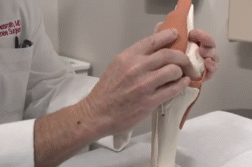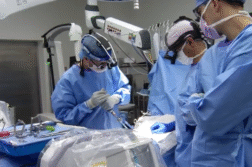CHICAGO, Ill. (Ivanhoe Newswire) – It’s been one year since Russia invaded the Ukraine. More than 70,000 Ukrainian soldiers have been killed and almost 100,000 wounded. Amid a growing humanitarian crisis, doctors and medical professionals from the United States are stepping up to provide vital aide. One Ukrainian soldier found help by doctors 5,000 miles away from his homeland. Arm
Andrii Dovhaichuk has been a DJ for decades, and when war tore his country apart, he immediately volunteered.
“I fight for my family, for my friends,” Andrii says.
Called to action to help fellow fighters who were surrounded by the enemy, he walked right into an ambush.
Andrii painfully recalls, “Our unit was shot by a tank.”
His arm almost completely gone, and after months fighting an infection, it looked like the only option was amputation, until a church in Chicago heard about Andrii and connected him with Xavier Simcock, MD, a Hand & Upper Extremity Surgeon at Midwest Orthopedics at Rush.
“The goal was to get rid of the infection, but then, to connect the rest of his arm through fusion and from the upper arm to the lower arm so that he still had a hand that he can use,” Dr. Simcock explains.
It took two surgeries – one to clear the infection and the second to fuse the arm together.
Dr. Simcock further explains, “He had multiple nerve injuries as well. So, we had to, kind of, put all those pieces together.”
More than a year after his injury, Andrii is able to move his once almost-amputated arm. He hopes to continue to get more movement back – at least enough to go home and join the fight again.
Andrii will continue to gain more movement in his wrist and hand for several more months. Recovery from this type of surgery can take up to two years.
Contributors to this news report include: Marsha Lewis, Producer; Kirk Manson, Videographer; Roque Correa, Editor.
To receive a free weekly e-mail on medical breakthroughs from Ivanhoe, sign up at: http://www.ivanhoe.com/ftk
Source:
https://www.nytimes.com/2023/08/18/us/politics/ukraine-russia-war-casualties.html
MEDICAL BREAKTHROUGHS
RESEARCH SUMMARY
TOPIC: SAVING A UKRAINIAN SOLDIER: REPAIRING ANDRII’S ARM
REPORT: MB #5278
BACKGROUND: An open wound is any injury that occurs internally or externally and results in exposed internal tissue. Acute open wounds can be tended to at home through natural remedies or medications; however, if substantial bleeding occurs or broken bone is evident, the individual needs medical attention immediately. There are several types of open wounds including: abrasion, laceration, avulsion, puncture, and incision. An abrasion is a wound that happens when skin rubs or slides against a rough surface. Lacerations are deep tears in the skin. These typically occur from accidents involving sharp tools such as knives or metal machinery. Avulsions are wounds that rip away the skin and internal tissue. These are usually the result of tragic accidents such as animal attacks, car accidents, or explosions. A puncture wound is the piercing of soft tissue. It’s a small hole and is apparent in acute injuries like splinters or needle jabs. However, puncture wounds like knife stabbings or gunshot wounds can obstruct internal organs and produce significant bleeding.
(Source: https://www.medicalnewstoday.com/articles/325260#types)
TREATMENT: To properly care for an open wound, controlling the bleeding is imperative. With slight pressure, use a clean wrap or bandage to encourage blood clotting so the bleeding stops. Once bleeding stops, use a mixture of sodium chloride and water to clean away any bacteria or debris in or around the wound. If glass, dead tissue, bullets, etc. are present, surgical removement is required. After the site’s been cleaned, the wound should be treated with antibiotics to prevent infection. Then, the wound should be bound with gauze or waterproof bandages to encourage swift recovery. Deeper open wounds may need staples or stitches to effectively close the injury. Finally, the CDC recommends old gauze and bandages are checked for signs of infection every 24 hrs. Keep the wound dry throughout the healing period and always disinfect the wound before applying clean gauze and bandages.
(Source: https://www.medicalnewstoday.com/articles/325260#medications)
NEW TECHNOLOGY: To repair Andrii’s arm, there were a series of steps his doctors followed to restore range of movement. The first step was to clear the infection. He had a big exposed wound on the outside of his elbow. Doctors were diligent to ensure they cleared out everything that could potentially cause further harm. They then used a combination of antibiotics, as well as IV antibiotics, in the wound site to help stabilize the elbow and ensure there was an adequate amount of healing. At that point, the doctors then moved muscle around. The elbow was stabilized by fusing the upper arm and lower arm bone together.
(Source: https://www.ivanhoe.com/)
FOR MORE INFORMATION ON THIS REPORT, PLEASE CONTACT:
Ann Pitcher
If this story or any other Ivanhoe story has impacted your life or prompted you or someone you know to seek or change treatments, please let us know by contacting Marjorie Bekaert Thomas at mthomas@ivanhoe.com




